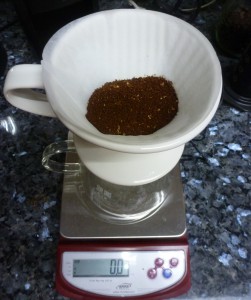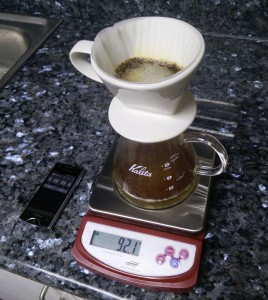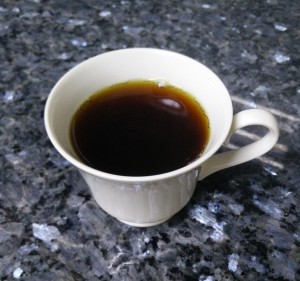They there coffee lovers! Today, we’re going to make coffee using the Kalita 102. This is a wedge-type or Melitta-type coffee brewer. It has ridges on the sides and 3 holes at the bottom to extract the coffee. As a pour-over brewer, this falls under the same category as the Hario V60 dripper.
A few details before we start brewing
For the purposes of this tutorial, we’re going to brew a 6 US oz (180 ml) batch.
Bean to Water Ratio
 Here’s the magic number when you need to know how much beans to start with when you brew your coffee:
Here’s the magic number when you need to know how much beans to start with when you brew your coffee:
It’s 1 part coffee is to 15 parts water.
The easiest way to apply this is by using 10 grams of coffee beans and brewing with the equivalent amount of water. So 10 grams of coffee to 150 ml water, 20 grams to 300 ml, and so forth. But since we’re only making a cup of coffee which is 180 ml, we’ll use 12 grams of coffee beans (180 ml target volume / 15 = 12 grams of coffee).
If you find that your coffee is weak, increase the ratio to 16. The opposite is also true that if you have a weak brew, decrease the ratio to 14.
In short, you’d want your coffee to water ratio somewhere between 14 and 16. This time, we’re using a ratio of 15.
Grind Size
For the grind size, we’re going to use a medium grind. On my Baratza Encore, I use a grind size of 18 or 19, so that’s a click lower than the middle grind size of the Encore (it has 40 grind settings).
On your grinder, look for the middle setting and give it a click downwards, that should be a good point to start with.
If you are brewing more than 180 ml of coffee, which I’m sure you are, go a bit coarser on the grind size. But more on that at the end of this post.
For more information on grind sizes, check out this post.
Checklist
Now that we have the math down, let’s start making sure we have all other items ready. In my experience, I usually forget the timer (since I use my cellphone) and find myself running over to get it before I begin brewing. So here’s the checklist:
- Filtered water, boiled, and at 195-205 degrees Fahrenheit (95.6 to 96.1 degrees Celsius), about 500 ml (17 oz).
- 12 grams of coffee for 180 ml of water
- Kalita 102 brewer with the appropriate paper filter
- Gooseneck Kettle
- Carafe or cup – Carafe to transfer the coffee into a cup, giving you that barista feeling. Or you can just place it straight on top of a cup.
- Weighing scale
- Timer (The last item that’s easy to forget.)
- Thermometer (Optional) – This thermometer will help you know when the water temperature has reached optimal brewing temperature already.

Pre-brew Stage (Heating Everything Up)
This is the stage where you set everything up before you do your brewing. Although it might have a few items in the list, you can do everything at the same time and it’ll take only about 2 to 3 minutes to finish.
 Filter and boil the water.
Filter and boil the water.- While you’re waiting for the water to boil, start assembling the brewer. Paper filter on top of the brewer, then place the brewer on top of the carafe.
- After step #2, you’re water should still be heating up. This would be a good time to start grinding your coffee beans. Don’t take the grounds out of the grounds container yet.
- Once the water has boiled, transfer a small amount of the water (about 200 ml or 7 oz) to the gooseneck kettle to start heating it up. Swirl the kettle so it heats up faster.
*Note: This is why I advised you to boil 500 ml or 17 oz of water. You could have hot water to pre-heat the items, and still have enough to brew your coffee.
- Once the gooseneck kettle is sufficiently hot, pour all the water unto the brewer, with the paper filter inside it, to pre-heat the brewer and get rid of any paper taste.
 The water will drip down to the carafe and this will sufficiently heat the carafe also.
The water will drip down to the carafe and this will sufficiently heat the carafe also. - Discard the water in the carafe.
- Place the coffee grounds in the pre-heated brewer.
- Reset your weighing scale, or tare it to zero.
- Transfer the remaining water into the gooseneck kettle, and we’re ready to brew!
*Note: Steps 4-9 would take about 30 seconds to 1 minute if done in sequence. That’s just about the right time for your newly boiled water to go down to the 195-205 degrees Fahrenheit range.
Time to Brew Our Coffee
- Start your timer and add only 10% of the total water volume. In this case, Start adding 18 ml of water.
 Allow it to bloom for 30 seconds. Blooming is important because it degases all the excess CO2 from the coffee that came with the roasting process. With the CO2 gone, the water will pass through all the grounds once you start brewing, allowing for better extraction.
Allow it to bloom for 30 seconds. Blooming is important because it degases all the excess CO2 from the coffee that came with the roasting process. With the CO2 gone, the water will pass through all the grounds once you start brewing, allowing for better extraction.- After 30 seconds, begin slowly adding water in a small spiral motion, from the center moving outward. The direction doesn’t matter, but stick to that particular direction for the rest of the brewing process. Just add a small amount of water and allow it to go a little above the coffee bed.
- Allow the water level to drop a little, then start adding water using the same spiral formation, from teh center moving outward, until you reach a target weight, or a certain height in your brew.
- Repeat step #4 until you reach the target volume of 180 ml or 6 oz.
- Target brew time for this 6 oz cup should be around 2 minutes and 30 seconds.
Brew Time Cheat Sheet
This brew time method was developed to help beginner brewers in reaching the target brewing time of 2:30 using6 oz or 120 ml water.
Using ounces:
Start the timer, add 0.6 oz to 1 oz water
At 0:30, add water and target a total volume of 3 oz water
At 1:20, add water and target a total volume of 4 oz water
At 1:40, add water and target a total volume of 5 oz water
At 2:10, add water and target a total volume of 6 oz water
At around 2:30, your brew should end
Using milliliters:
Start the timer, add 18 to 20 ml water
At 0:30, add water and target a total volume of 90 ml water
At 1:20, add water and target a total volume of 120 ml water
At 1:40, add water and target a total volume of 150 ml water
At 2:10, add water and target a total volume of 180 ml water
At around 2:30, your brew should end
Remember that this is not a specific timeline. Brewing time will change based on many variables. You will develop your own brew style and preference in time.
Brewing for Bigger Volumes
6 oz or 180 ml is a good number to begin with. But we all know that in today’s time, that amount is really quite small. Thanks to Starbucks, a cup of coffee doesn’t seem to cut it anymore. So let’s talk about brewing for bigger volumes.
No matter if we’re brewing for 8, 10, or 12 oz of coffee, amount of beans to water ratio will not change. It’s always good at 15. Increase or decrease the ratio as needed.
As for grind sizes, You will need to increase the grind size. Depending on the grinder that you use, this could be anywhere between one to two clicks to a coarser grind. The higher the volume of coffee, the bigger the grind size.
And finally, for brew time, you’ll need to increase it as well. For 8 oz (240 ml), target a total of 2:45. For 10 oz (300 ml), target 3:00 flat. And for a whopping 4 cups or 15 oz (450 ml), you could go anywhere between 4 minutes and 4:30.
And there you have it folks! A perfect cup of coffee made by you!

Would you like to share your experiences in making your pour over coffee? Do you use the Kalita or other brewers in making your coffee? Which one do you prefer? Share them on the comments below.

I have to admit, I’m not a massive lover of coffee… but since ice coffee has been around I’ve been slowly building up a tolerance/liking for it!! Maybe trying these steps will help me start enjoying it more?? Think I’ll have to give it a go – Thank you for sharing!!
Zoe
Hi there Zoe! Most coffee lovers started drinking from the old type of coffee, which is blended, and would have a lot of Robusta (the earthy, bitter tastes) beans in it. Nowadays, coffee farmers tend to make high quality Arabica bean batches. Try some out at your local brewer. And as you like cold coffee, try their iced cold brew. I think you’ll favor that a lot more with its lower acidity and subtler taste. Thanks for posting!
Having it done everyday, I tend not to use weighing scales anymore. It is by instinct I can tell I’m doing it perfectly. The quest now is to find awesome beans (single origin) lately I’ve been into highlands coffee produced by local farmers.
That’s pretty good. I still use my scale up until now. I could probably use measuring spoons to have a basic idea of how much I need. But beans sometimes weigh differently depending on its origin too. I get my coffee mostly from a local roaster. They import single origin coffee from a lot of places like Kenya, Ethiopia, Panama, etc. And most of them taste really good too! I never liked acidic coffee until I made my own. The tastes are awesome.
I recently got a some single origin roasts on my last trip to Japan too and I’m really excited to try it out 🙂 Just as soon as I finish this current batch that I’m almost done with.
Thanks for the detailed article! I was looking for some info about total time to brew size and your “Bigger Volumes” section is perfect!
What kind of timer is that in the picture? Do you like it? It looks sweet, want to get one myself!
Thanks!
Hi Austin! Thanks for taking the time to read. I’m glad i was able to help you out some.
Oh the timer is my phone app. I just put it on landscape mode so i can press the start button faster. Thank for your kind comment about it too 🙂
Thank you for taking the time to write this! I just got a Kalita 102 today and will be trying it out using your instructions first thing tomorrow morning. I don’t have my gooseneck kettle just yet(it’s arriving tomorrow), but have everything else and a pretty steady pouring hand, so we’ll see how it goes. 🙂
Hi David. I hope you enjoy your Kalita, and more importantly, your coffee 🙂 I’ll be posting my way of making coffee nowadays in a few days. Hope you can come by and see it 🙂 Thanks for reading and I hope the post will be of great help to you!